#film art
Text

Megan Fox in Jennifer's Body, (2009)
#body art#a e s t h e t i c#hot as fuck#nudity#sexy tease#sexy content#megan fox#movie scenes#movie stills#movie art#movie aesthetic#film stills#film and television#film art#film aesthetic#cinephile#cinema
68 notes
·
View notes
Text
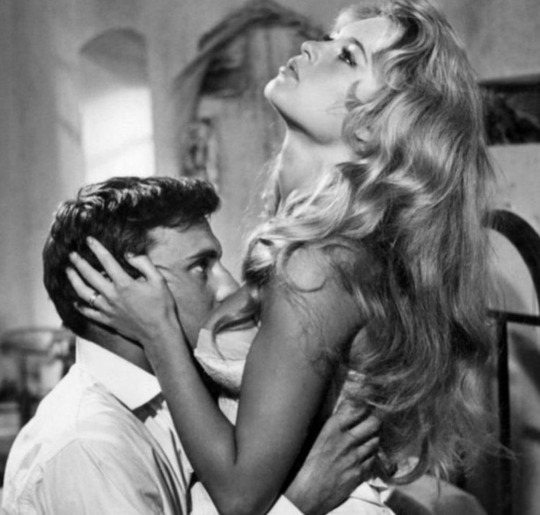
#aesthetic#art#fashion#dark#black#photography#brigitte bardot#movie icons#filmcamera#film art#black and grey#black and white#vintage#girls icons#iconic#icons#soft icons#couple#feminine style#femininity#femme fatale#divine feminine#femme#the sacred feminine#female#beautiful women#actors#actor#actress#lovecore
898 notes
·
View notes
Text



Hello there! Feeling blessed to be able to share this before what I had anticipated! 😬
Here's my full Obi-Wan Kenobi poster I teased last week. Had a ton of fun illustrating this one! It won't be available for APs just yet, so keep an eye in the future if you're interested.
Hope you like it and please share! 🙏
Follow me here: Twitter ǀ Instagram ǀ ArtStation ǀ Facebook
My website: https://www.wolfgangleblanc.com/
#Star wars day#star wars#may the 4th be with you#obi wan kenobi#leia#leia organa#darth vader#anakin skywalker#luke skywalker#ewan mcgregor#poster art#film art#movie art#jedi#princess leia#hayden christensen#prequel trilogy
602 notes
·
View notes
Text
The front of a birthday card I made for a friend I saw Asteroid City with 💖

#painting#watercolor#watercolorpainting#artists on tumblr#sketch#art#wes anderson#asteroid city#movie#wes anderson movies#film#cinema#alien#jason schwartzman#maya hawke#film art#alien art#fanart
410 notes
·
View notes
Text

choose life or whatever 🚬
#trainspotting#trainspotting art#film art#mark renton#francis begbie#obvious robert valley inspiration#kisa art
144 notes
·
View notes
Text

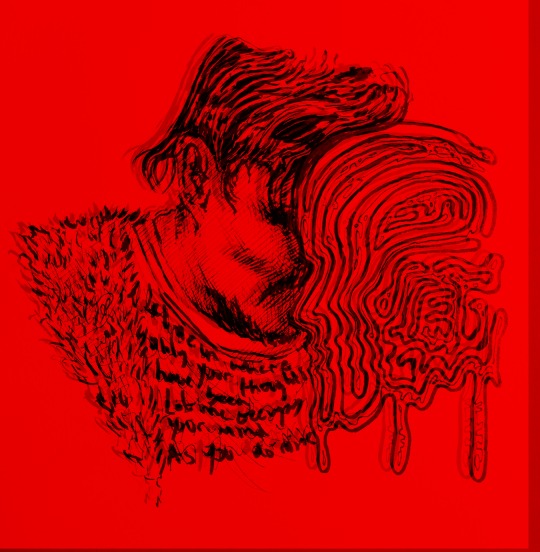
the passenger (2023) got me good so like here's a sketch based on it lol
(03/2024)
featuring lyrics from the song 'hearts a mess' by gotye because i feel they Heavily relate to benson's character lol
#the passenger#the passenger 2023#artists on tumblr#benson the passenger#randy bradley#sketch#ink drawing#tw eyestrain#film art#traditional art#colour and effects added digitally btw#this is a very rough/simple thing#so i mayyyy to something more detailed if the brain worms persist pfft....
93 notes
·
View notes
Text
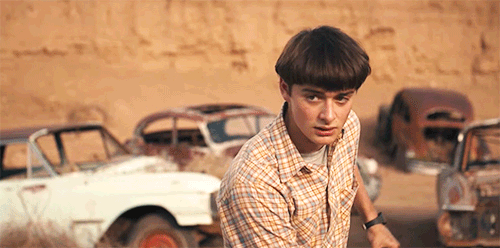
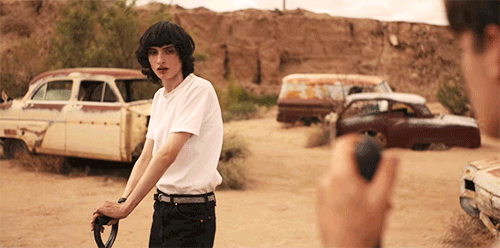
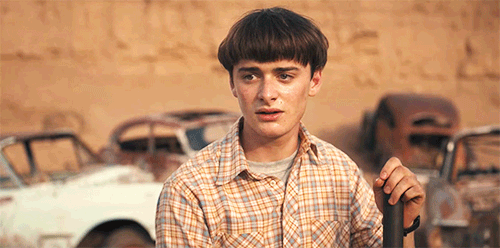
stranger things
#stranger things 4#32#will byers#mike wheeler#lgbtiq#lgbtq#aesthetic#indie#netfilx#film art#pride#pride month#bisexual#neon#psd#edit
3K notes
·
View notes
Text

there’s only one allan! 🧡🩷
insta <3
#allan#allan barbie#barbie allan#michael cera#barbie#barbie movie#Barbie the movie#I love him so much it’s crazy#art#fanart#digital art#film art#sleepycrawlies#sleepycrawly
247 notes
·
View notes
Text
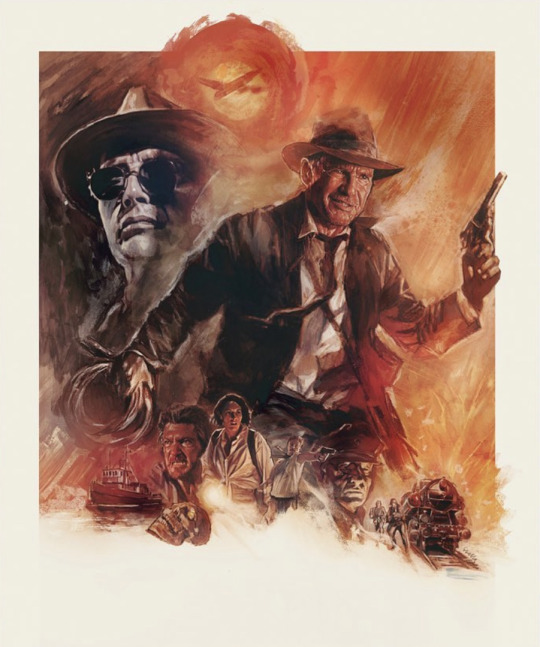
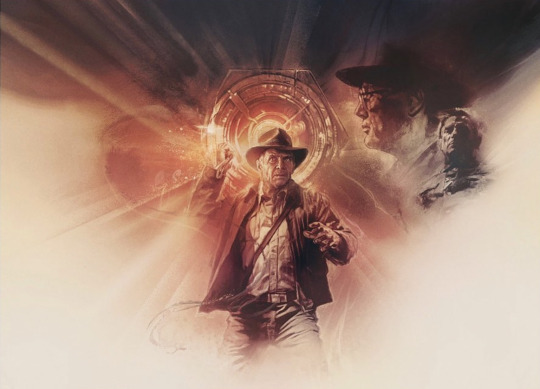


[“Indiana Jones and the Dial of Destiny” artwork by Tony Stella]
- WDD
#harrison ford#harrisonford#indianajones#Indiana Jones#tony stella#art#Tony Stella art#indiana jones and the dial of destiny#dial of destiny#lucasfilm#movies#film#art for film#film art#harrisance#witness the harrisance
351 notes
·
View notes
Text
How’d They Do That?
Special Effects & Stunts of Silent Cinema - Part 1
This is the first installment of an open-ended series where I try to highlight and illustrate the work of special effects and stunt artists of silent filmdom. Using articles from contemporary fan and trade magazines, I’ll make gifs or dig up images and/or video clips to accompany the descriptions of how the sequences were executed.
My notations will be bracketed and highlighted in a different color. Hope you all enjoy! Fair warning: this is a long read.
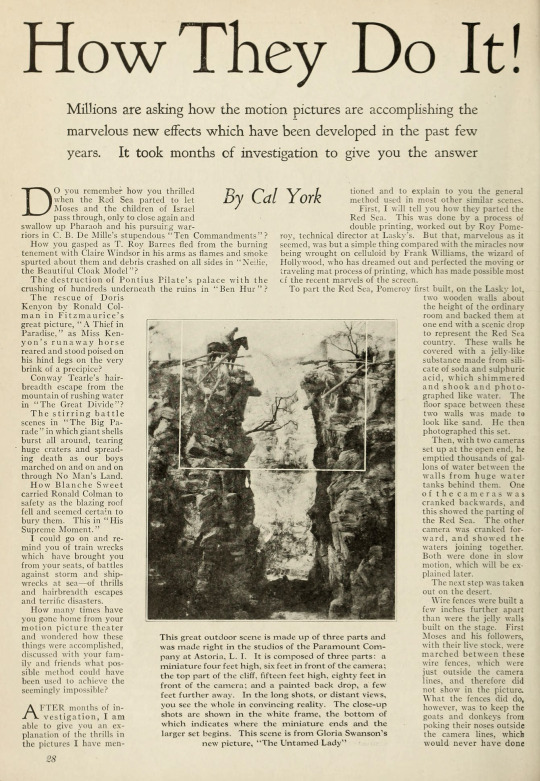
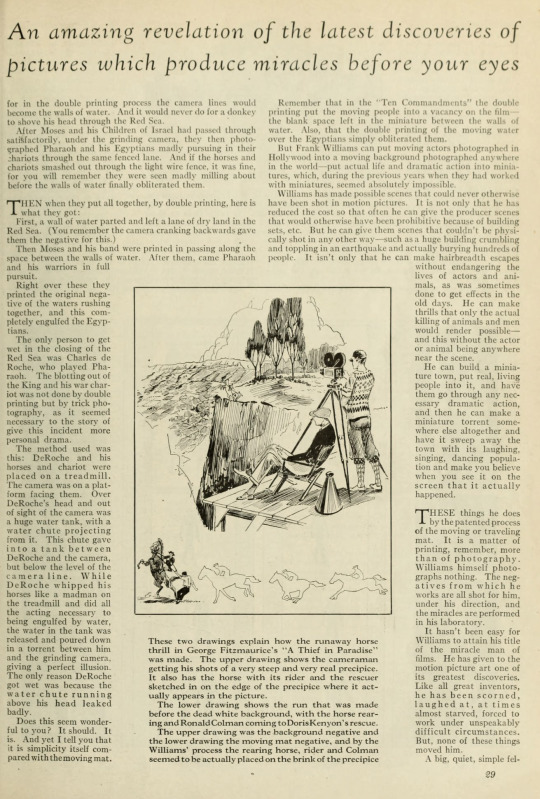
How They Do It!
[from Photoplay, April 1926]
by Cal York
Millions are asking how the motion pictures are accomplishing the marvelous new effects which have been developed in the past few years. It took months of investigation to give you the answer
DO you remember how you thrilled when the Red Sea parted to let Moses and the children of Israel pass through, only to close again and swallow up Pharaoh and his pursuing warriors in C.B. De Mille's stupendous "Ten Commandments" ?
How you gasped as T. Roy Barnes fled from the burning tenement with Claire Windsor in his arms as flames and smoke spurted about them and debris crashed on all sides in "Nellie, the Beautiful Cloak Model"?
The destruction of Pontius Pilate's palace with the crushing of hundreds underneath the ruins in "Ben Hur"?
The rescue of Doris Kenyon by Ronald Colman in Fitzmaurice's great picture, "A Thief in Paradise," as Miss Kenyon's runaway horse reared and stood poised on his hind legs on the very brink of a precipice?
Conway Tearle's hair-breadth escape from the mountain of rushing water in "The Great Divide"?
The stirring battle scenes in "The Big Parade" in which giant shells burst all around, tearing huge craters and spreading death as our boys marched on and on and on through No Man's Land.
How Blanche Sweet carried Ronald Colman to safety as the blazing roof fell and seemed certain to bury them. This in "His Supreme Moment."
I could go on and remind you of train wrecks which have brought you from your seats, of battles against storm and shipwrecks at sea—of thrills and hairbreadth escapes and terrific disasters.
How many times have you gone home from your motion picture theater and wondered how these things were accomplished, discussed with your family and friends what possible method could have been used to achieve the seemingly impossible?
AFTER months of investigation, I am able to give you an explanation of the thrills in the pictures I have mentioned and to explain to you the general method used in most other similar scenes.
First, I will tell you how they parted the Red Sea. This was done by a process of double printing, worked out by Roy Pomeroy, technical director at Lasky's. But that, marvelous as it seemed, was but a simple thing compared with the miracles now being wrought on celluloid by Frank Williams, the wizard of Hollywood, who has dreamed out and perfected the moving or traveling mat process of printing, which has made possible most of the recent marvels of the screen.
[Roy Pomeroy was head technical wizard for Famous Players-Lasky/Paramount (that is to say, he was their head special-effects engineer). We only know for certain about a handful of films that Pomeroy made specific contributions to, like The Ten Commandments (1923) and Wings (1927). As with many journeymen of the silent/studio era of Hollywood, the amount of films Pomeroy worked on was likely substantial, but many technical roles went uncredited at the time.]
To part the Red Sea, Pomeroy first built, on the Lasky lot, two wooden walls about the height of the ordinary room and backed them at one end with a scenic drop to represent the Red Sea country. These walls he covered with a jelly-like substance made from silicate of soda and sulphuric acid, which shimmered and shook and photographed like water. The floor space between these two walls was made to look like sand. He then photographed this set.

Then, with two cameras set up at the open end, he emptied thousands of gallons of water between the walls from huge water tanks behind them. One of the cameras was cranked backwards, and this showed the parting of the Red Sea. The other camera was cranked forward, and showed the waters joining together. Both were done in slow motion, which will be explained later.

The next step was taken out on the desert.
Wire fences were built a few inches further apart than were the jelly walls built on the stage. First Moses and his followers, with their live stock, were marched between these wire fences, which were just outside the camera lines, and therefore did not show in the picture. What the fences did do, however, was to keep the goats and donkeys from poking their noses outside the camera lines, which would never have done for in the double printing process the camera lines would become the walls of water. And it would never do for a donkey to shove his head through the Red Sea.
After Moses and his Children of Israel had passed through satisfactorily, under the grinding camera, they then photographed Pharaoh and his Egyptians madly pursuing in their chariots through the same fenced lane. And if the horses and chariots smashed out through the light wire fence, it was fine. for you will remember they were seen madly milling about before the walls of water finally obliterated them.
THEN when they put all together, by double printing, here is what they got:
First, a wall of water parted and left a lane of dry land in the Red Sea. (You remember the camera cranking backwards gave them the negative for this.)
Then Moses and his band were printed in passing along the space between the walls of water. After them, came Pharaoh and his warriors in full pursuit.
Right over these they printed the original negative of the waters rushing together, and this completely engulfed The Egyptians.

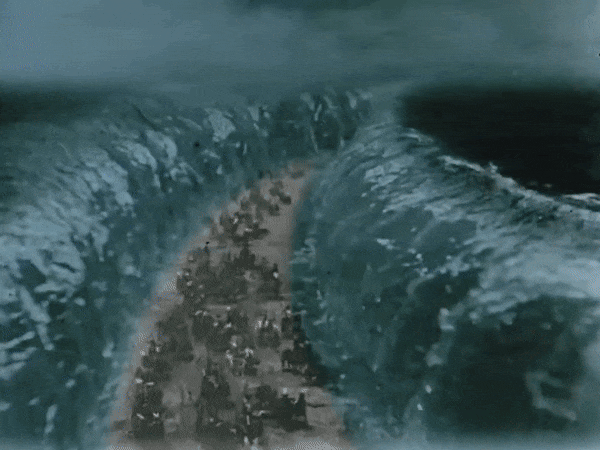
The only person to get wet in the closing of the Red Sea was Charles de Roche, who played Pharaoh. The blotting out of the King and his war chariot was not done by double printing but by trick photography, as it seemed necessary to the story of give this incident more personal drama.

The method used was this: DeRoche and his horses and chariot were placed on a treadmill. The camera was on a platform facing them. Over DeRoche's head and out of sight of the camera was a huge water tank, with a water chute projecting from it. This chute gave into a tank between DeRoche and the camera, but below the level of the camera line. While DeRoche whipped his horses like a madman on the treadmill and did all the acting necessary to being engulfed by water, the water in the tank was released and poured down in a torrent between him and the grinding camera, giving a perfect illusion. The only reason DeRoche got wet was because the water chute running above his head leaked badly.
Does this seem wonderful to you? It should. It is. And yet I tell you that it is simplicity itself compared with the moving mat.
Remember that in the "Ten Commandments" the double printing put the moving people into a vacancy on the film—the blank space left in the miniature between the walls of water. Also, that the double printing of the moving water over the Egyptians simply obliterated them.
READ ON BELOW the JUMP!
---
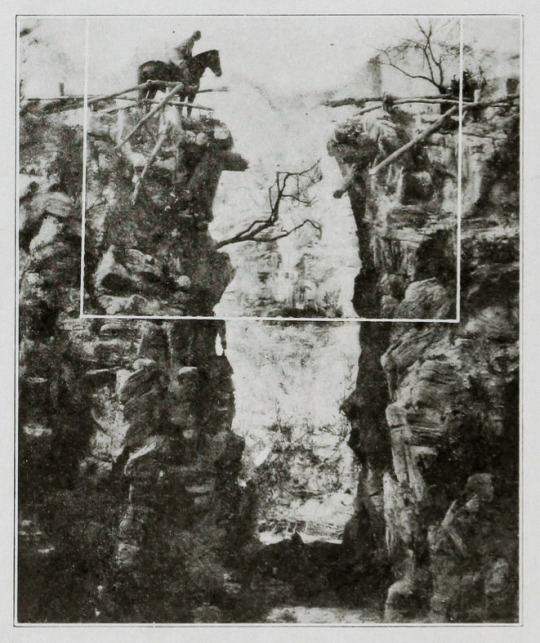
Photo caption: This great outdoor scene is made up of three parts and was made right in the studios of the Paramount Company at Astoria, L.I. It is composed of three parts: a miniature four feet high, six feet in front of the camera; the top part of the cliff, fifteen feet high, eighty feet in front of the camera; and a painted back drop, a few feet further away. In the long shots, or distant views, you see the whole in convincing reality. The close-up shots are shown in the white frame, the bottom of which indicates where the miniature ends and the larger set begins. This scene is from Gloria Swanson's new picture, "The Untamed Lady"
[The Untamed Lady (1926) is presumed lost, but luckily, a few images of this cliff-top sequence have survived.
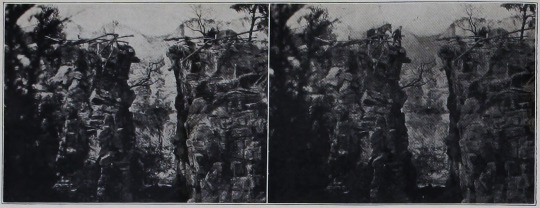

from Exhibitors Herald, 20 March 1926]
An amazing revelation of the latest discoveries of pictures which produce miracles before your eyes
---
But Frank Williams can put moving actors photographed in Hollywood into a moving background photographed anywhere in the world—put actual life and dramatic action into miniatures, which, during the previous years when they had worked with miniatures, seemed absolutely impossible.
[As you can gather from this article Frank Williams was a pioneer cinematographer and special effects artist. Williams was able to patent his moving matte process (and named it the Williams process) and it was an important effects technique used in film as as varied as Ben-Hur (1925), Sunrise: A Song of Two Humans (1926), The Lost World (1925), and The Invisible Man (1933). All of which are extant and easily accessible!
While it wasn’t in regular use for very long, the process was the basis for significant later developments in special effects photography, like green screening!]
Williams has made possible scenes that could never otherwise have been shot in motion pictures. It is not only that he has reduced the cost so that often he can give the producer scenes that would otherwise have been prohibitive because of building sets, etc. But he can give them scenes that couldn't be physically shot in any other way—such as a huge building crumbling and toppling in an earthquake and actually burying hundreds of people. It isn't only that he can make hairbreadth escapes without endangering the lives of actors and animals, as was sometimes done to get effects in the old days. He can make thrills that only the actual killing of animals and men would render possible—and this without the actor or animal being anywhere near the scene.
He can build a miniature town, put real, living people into it, and have them go through any necessary dramatic action, and then he can make a miniature torrent somewhere else altogether and have it sweep away the town with its laughing, singing, dancing population and make you believe when you see it on the screen that it actually happened.
THESE things he does by the patented process of the moving or traveling mat. It is a matter of printing, remember, more than of photography. Williams himself photographs nothing. The negatives from which he works are all shot for him, under his direction, and the miracles are performed in his laboratory.
It hasn't been easy for Williams to attain his title of the miracle man of films. He has given to the motion picture art one of its greatest discoveries. Like all great inventors, he has been scorned, laughed at, at times almost starved, forced to work under unspeakably difficult circumstances. But, none of these things moved him.
A big, quiet, simple fellow, only thirty-two years old. Shy, rather diffident of speech, he makes everything he does look easy. When he comes on a set, his quiet presence is scarcely noticed, and cameramen and technical experts go on spluttering and arguing, and when he is finally appealed to, he settles the problem so simply that everyone wonders why he didn't think of it himself.
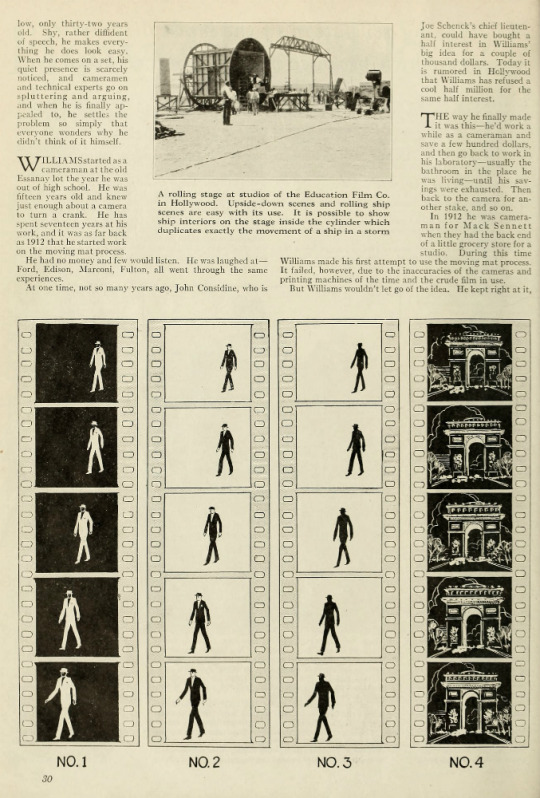
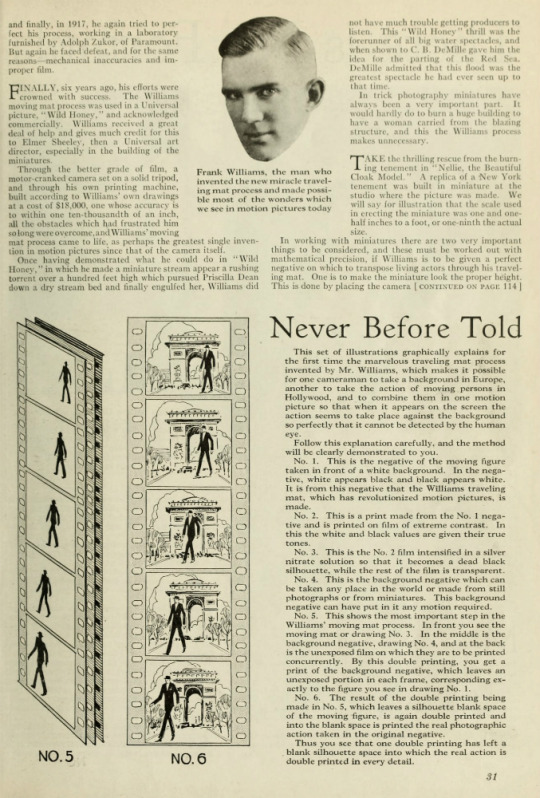
WILLIAMS started as a cameraman at the old Essanay lot the year he was out of high school. He was fifteen years old and knew just enough about a camera to turn a crank. He has spent seventeen years at his work, and it was as far back as 1912 that he started work on the moving mat process.
He had no money and few would listen. He was laughed at—Ford, Edison, Marconi, Fulton, all went through the same experiences.
At one time, not so many years ago, John Considine, who is Joe Schenck's chief lieutenant, could have bought a half interest in Williams' big idea for a couple of thousand dollars. Today it is rumored in Hollywood that Williams has refused a cool half million for the same half interest.
THE way he finally made it was this—he'd work a while as a cameraman and save a few hundred dollars, and then go back to work in his laboratory—usually the bathroom in the place he was living—until his savings were exhausted. Then back to the camera for another stake, and so on.
In 1912 he was cameraman for Mack Sennett when they had the back end of a little grocery store for a studio. During this time Williams made his first attempt to use the moving mat process. It failed, however, due to the inaccuracies of the cameras and printing machines of the time and the crude film in use.
But Williams wouldn’t let go of the idea. He kept right at it, and finally, in 1917, he again tried to perfect his process. working in a laboratory furnished by Adolph Zukor, of Paramount. But again he faced defeat, and for the same reasons—mechanical inaccuracies and improper film.
---
Photo caption: A rolling stage at studios of the Education Film Co. in Hollywood. Upside-down scenes and rolling ship scenes are easy with its use. It is possible to show ship interiors on the stage inside the cylinder which duplicates exactly the movement of a ship in a storm
[The rolling stage was used for lots of imaginative and comedic sequences in shorts and features. In the Lupino Lane short Movieland (1926), there’s a bit that shows the stage in action. Here’s a link to that specific scene, but the whole short is a lot of wacky fun and I recommend watching the full film!
Another illustration of how the rolling stage can be put to use is in When the Clouds Roll By (1919):
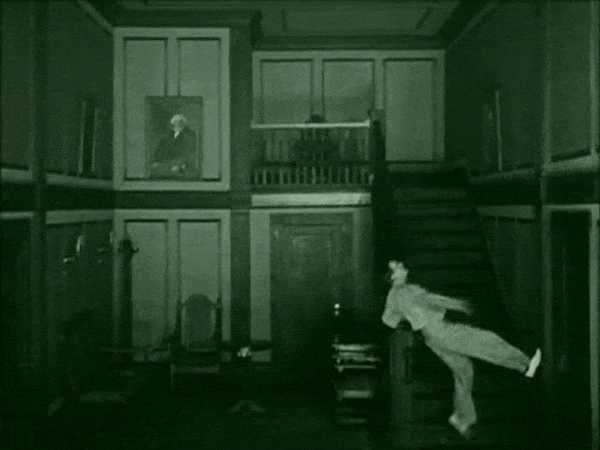

---
FINALLY, six years ago, his efforts were crowned with success. The Williams moving mat process was used in a Universal picture, "Wild Honey," and acknowledged commercially. Williams received a great deal of help and gives much credit for this to Elmer Sheeley, then a Universal art director, especially in the building of the miniatures.
Through the better grade of film, a motor-cranked camera set on a solid tripod, and through his own printing machine, built according to Williams' own drawings at a cost of $18,000, one whose accuracy is to within one ten-thousandth of an inch, all the obstacles which had frustrated him so long were overcome and Williams' moving mat process came to life, as perhaps the greatest single invention in motion pictures since that of the camera itself.
Once having demonstrated what he could do in "Wild Honey," in which he made a miniature stream appear a rushing torrent over a hundred feet high which pursued Priscilla Dean down a dry stream bed and finally engulfed her, Williams did not have much trouble getting producers to listen. This "Wild Honey" thrill was the forerunner of all big water spectacles, and when shown to C.B. DeMille gave him the idea for the parting of the Red Sea. DeMille admitted that this flood was the greatest spectacle he had ever seen up to that time.
[Unfortunately, Wild Honey (1922) is currently presumed lost and I was unable to find any depiction of Priscilla Dean fleeing from a torrent of water. As noted above however, there are quite a few extant films that also used Williams’ moving matte process.
In case you were wondering, I put $18,000 through an inflation calculator and it is equivalent to more than $315,000 in 2023 money!]
In trick photography miniatures have always been a very important part. It would hardly do to burn a huge building to have a woman carried from the blazing structure, and this the Williams process makes unnecessary.
TAKE the thrilling rescue front the burning tenement in "Nellie, the Beautiful Cloak Model." A replica of a New York tenement was built in miniature at the studio where the picture was made. We will say for illustration that the scale used in erecting the miniature was one and one-half inches to a foot, or one-ninth the actual size.
In working with miniatures there are two very important things to be considered, and these must be worked out with mathematical precision, if Williams is to be given a perfect negative on which to transpose living actors through his traveling mat. One is to make the miniature look the proper height. This is done by placing the camera the proper distance from the miniature (of course much closer than if it were a real building), and shooting from a lower level. The other is called timing. For example, if a miniature tree is to fall and the camera set-up is close enough and low enough to give the miniature the proper height when it is seen on the screen, then you must be careful of the speed with which it falls.
A little tree falls rapidly—a big tree slowly. And here is where the timing enters. Ultra speed cameras are used. The faster you crank the more pictures you get per second, and the slower the thing seems to move when you see it on the screen. You have all seen slow-motion pictures. These were made with slow-motion cameras, or what are more commonly termed ultra-speed cameras. And it is through this slow motion photography that the little tree is made to fall at the proper speed to be the big tree it represents, or the miniature stream is made to run at the proper speed for a giant river.
And so to get back to the fire which is still threatening "Our Nell." A torch is applied to the miniature tenement. At the proper count little invisible wires tied to window sashes are pulled and burning brands crash to the street below. And all the time the cameras, driven by motors at the proper speed, placed at the right distance from the conflagration and almost flat on the floor, are grinding away and recording this great fire.
[Nellie, the Beautiful Cloak Model (1924) is extant, with a print located at Gosfilmofond, but the film is not readily accessible. However, a depiction of the burning building sequence appears on an advertisement for the film:

from Film Daily, 28 February 1924]
OVER on some other part of the lot, and at any time which suits the director's convenience, T. Roy Barnes, with Miss Windsor in his arms, dashes through a black velvet door and down a street backed with more black velvet.
Two things must be remembered, however. The actors must come out of the velvet door at the right spot and at the right time or "count." This is necessary so that Williams can match up the fire negative, which is the background with action in it, with the negative of Miss Windsor and Barnes, which becomes the moving mat.
The remainder is simple, and is done by Williams and his printing process over at his laboratory.
On the screen you see Barnes dashing from a burning tenement with Miss Windsor in his arms while, in reality, neither of the actors has been close enough to a fire to singe a single eyelash.
Blanche Sweet's rescue of Colman in "The Supreme Moment" was worked out in the same manner as this, as have been most other burning building thrills in pictures made in the last few years.
[His Supreme Moment (1925) is presumed lost and unfortunately I was unable to locate a depiction of the burning building rescue mentioned here.]
Now for the destruction of Pontius Pilate's palace with the struggling mass crushed beneath, in "Ben Hur." Of course the palace was done in miniature, while the people did their acting out on the lot, where the street was built with a dead white backing. Again the timing had to correspond with that in the falling of the palace.
The throng of people was lined up and rehearsed. Two lines were drawn in the street a fixed distance apart—which represented the space where the ruins of the palace would fall, and the throng was sent dashing wildly down the street. At a fixed signal, all caught between the two marks fell flat on the ground. Those who had not reached the first line halted and registered terror. Those who had passed the second mark fled on, looking back and also registering terror. You see, those caught between the two marks were the people buried under the debris of Pilate's palace—those on either side had escaped.

Then came the trick printing with the two negatives, with considerable painting out of those who had fallen flat between the two lines, and you have the palace falling on the panic-stricken throng in the street. The accompanying drawings will help you to visualize this.
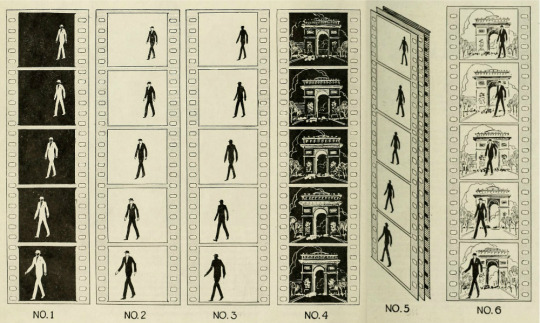
Never Before Told
This set of illustrations graphically explains for the first time the marvelous traveling mat process invented by Mr. Williams, which makes it possible for one cameraman to take a background in Europe, another to take the action of moving persons in Hollywood, and to combine them in one motion picture so that when it appears on the screen the action seems to take place against the background so perfectly that it cannot be detected by the human eye.
Follow this explanation carefully, and the method will be clearly demonstrated to you.
No. 1. This is the negative of the moving figure taken in front of a white background. In the negative, white appears black and black appears white. It is from this negative that the Williams traveling mat, which has revolutionized motion pictures, is made.
No. 2. This is a print made from the No. 1 negative and is printed on film of extreme contrast. In this the white and black values are given their true tones.
No. 3. This is the No. 2 film intensified in a silver nitrate solution so that it becomes a dead black silhouette, while the rest of the film is transparent.
No. 4. This is the background negative which can be taken any place in the world or made from still photographs or from miniatures. This background negative can have put in it any motion required.
No. 5. This shows the most important step in the Williams' moving mat process. In front you see the moving mat or drawing No. 3. In the middle is the background negative, drawing No. 4, and at the back is the unexposed film on which they are to be printed concurrently. By this double printing, you get a print of the background negative, which leaves an unexposed portion in each frame, corresponding exactly to the figure you see in drawing No. 1.
No. 6. The result of the double printing being made in No. 5, which leaves a silhouette blank space of the moving figure, is again double printed and into the blank space is printed the real photographic action taken in the original negative.
Thus you see that one double printing has left a blank silhouette space into which the real action is double printed in every detail.
---
The rescue of Doris Kenyon, which is also illustrated by the artist, was accomplished in this manner. One negative was shot of a very real and very steep precipice, the cameramen suspended on a platform far out over the edge to get the proper angle. Another negative was shot of Miss Kenyon's horse racing madly along what looked like a fence—but what was the inevitable white drop. Doris and the horse had to reach a certain mark at a certain count—for over at the precipice there had been rocks and dirt released at a certain count—the horse bad to rear, and Colman had to reach the frenzied beast, starting from outside the camera line, and he, too, must arrive on the right count. There could be no waiting for man or horse. They took it perhaps forty times before everything was exactly right, and then the two negatives (the precipice background and the moving mat) were ready for the printing wizard, and audiences got a great thrill.
[A Thief in Paradise (1925) is almost entirely lost. I profiled the film in my series Lost, but Not Forgotten in 2023.]
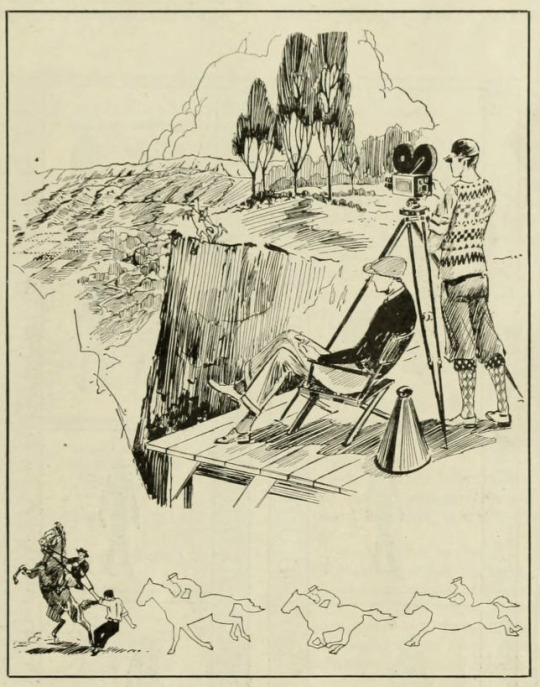
Photo caption: These two drawings explain how the runaway horse thrill in George Fitzmaurice's "A Thief in Paradise" was made. The upper drawing shows the cameraman getting his shots of a very steep and very real precipice. It also has the horse with its rider and the rescuer sketched in on the edge of the precipice where it actually appears in the picture.
The lower drawing shows the run that was made before the dead white background, with the horse rearing and Ronald Colman coming to Doris Kenyon's rescue.
The upper drawing was the background negative and the lower drawing the moving mat negative, and by the Williams' process the rearing horse, rider and Colman seemed to be actually placed on the brink of the precipice
---
You remember the mountain of water pursuing Conway Tearle in "The Great Divide." Of course they shot the torrent in miniature. Conway and his horse made their hairbreadth dash on a dark night and in an artificial rainstorm with nothing but a director threatening —then, although they did have quite a time making the steed climb a slippery and sloping wooden bridge, which was out on the back lot. Then up in Mr. Williams' laboratory, they finished one of the greatest thrills ever witnessed.
[While The Great Divide (1925) is thankfully extant at Cinemateket-Svenska Filminstitutet, it’s not easily accessible and I was unable to find a depiction of the effect.]
And the marvelous battle scenes in "The Big Parade." There were the big guns tearing huge craters in No Man's Land made on one negative, and the boys marched on and on and on in the other negative, and Mr. Williams brought them together in his printing laboratory. However, it was by no means as easy as it sounds, for this was one of the hardest pieces of moving mat printing ever accomplished.

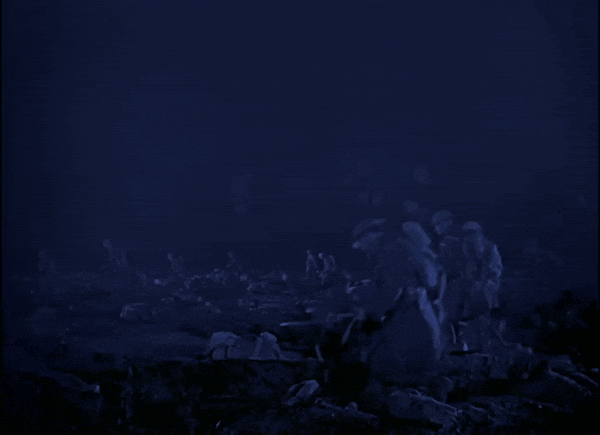

SO critical is the public that the building, photographing and printing of these miniatures must be of the very highest type of workmanship obtainable. It might be interesting to know that this work in "The Big Parade" alone cost approximately $70,000 for the background negative and the moving mat negative. The miniature battlefield was about one hundred thirty-five feet long and more than seven thousand miniature shells were fired in a period of forty seconds.
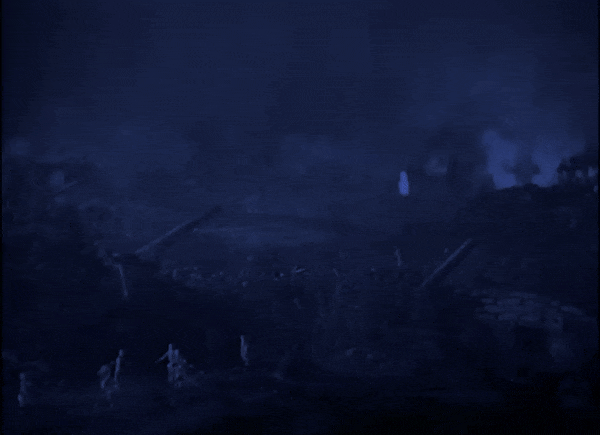



On another picture—"The Barrier"—which shows a fierce storm at sea, icebergs, and a ship caught and crushed in an ice floe, more than $85,000 have been spent to create these illusions.
[The Barrier (1926) is unfortunately presumed lost and I wasn’t able to find a depiction of this effect.]
Mr. Waller, technical camera expert of the Famous Players Long Island Studio, had never seen a cyclone; yet he was instructed to produce one for D. W. Griffith's picture, "That Royle Girl." Mr. Waller did extensive research work on the subject, and then made one to experiment with. A scientific knowledge of the working of the law of gravity, by the way, is necessary to create this phenomenon of nature.
[That Royle Girl (1925) is also presumed lost, and without film footage of this sequence there’s not really a way to know how the cyclone looked in the film. However, I do think the image highlighted in the advertisement below is likely from the cyclone sequence.
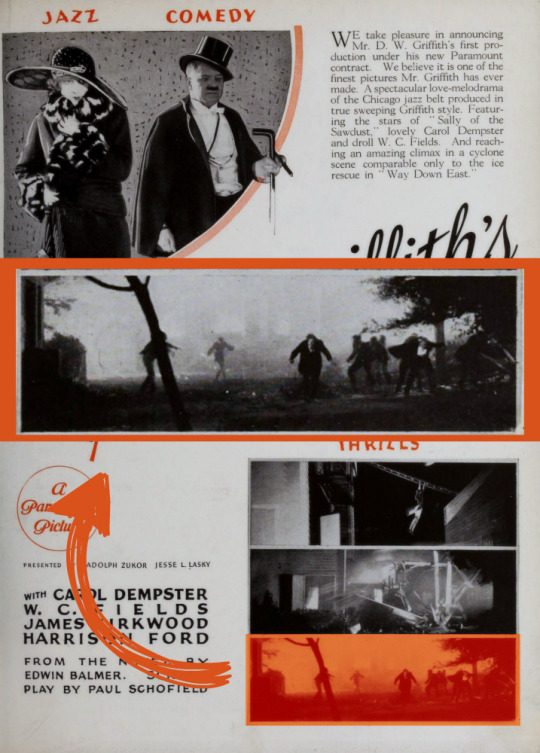
from Motion Picture News, 21 November 1925]
In the basement of the studio Mr. Waller connected up three vacuum cleaners. With three suctions of air and some dust, he made a tiny cyclone. This was photographed in slow motion so that the camera and technical crew might study the formation and activity of the cone.
From his observations of the film, Mr. Waller was able to prepare the series of wash drawings which, photographed in animated cartoon fashion, represented the action of the cyclone's cone in this sequence of the picture.
Several hundred drawings had to be made, each one depicting gradually the advance of the cone toward the Inn, which it finally demolishes. These were photographed in rotation on motion picture negative, and this negative double exposed on the 180-foot miniature scene containing the houses and trees. Thus we got a very good illusion of the cone of a cyclone advancing over a village and sweeping houses and trees out of its path.
[I wonder if/hope that some of these drawings have survived!]
The animated cartoon idea was also used in "A Kiss for Cinderella," when the pumpkin and mice change into the coach and four. The first few feet of the sequence showed real mice and pumpkin; from then on 256 wash drawings of the gradual transformation were photographed in rotation and gave the impression of being animated.
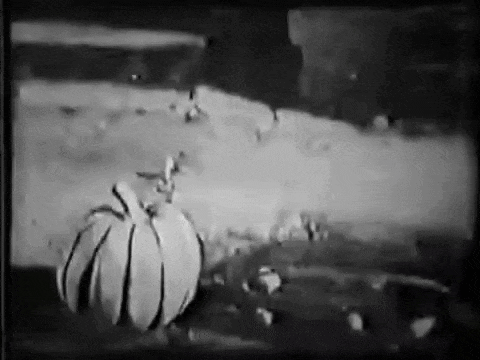
Double exposures of one actor playing two parts is the oldest and most familiar camera trick to the fans.
Just recently, however, has it been perfected to the point where the actor's two screen shadows can light each other's cigarettes and shake hands.
Tom Meighan, you recall, did this in Irish Luck."
AN invisible line from top to bottom divides each frame of the negative in half. One half at a time is exposed, photographing one half of the set.
Tom appears as Lord Fitzhugh on the left half, and as Tom Donohue on the right half. If you remember. Tom's two shadows are sitting side by side on a divan in the instance of the cigarette lighting. Fitzhugh leans over and gets a light from Donahue's cigarette. The illusion is perfect. But the cigarette from which his lordship really got the light was tacked onto a chair just outside the line, on the half of the set not being photographed at that moment. Only the lighted end of the cigarette projects into Fitzhugh's half of the picture.
[Irish Luck (1925) is extant at Eastman House, but it’s not currently easily accessible. I wasn’t able to find a depiction of this split-screen effect.]
Then when Donahue's half of the scene was being filmed, Tom leans forward and holds his cigarette in exactly the spot where the chair had been, the lighted end being outside his half of the picture. Think of the perfect matching this requires!
It is done this way. As Lord Fitzhugh performs on one side of the set, the director times his actions, counting the seconds out loud. He knows just where his lordship's right arm is, for instance, at the sixteenth second. When Donahue begins to perform on the other side of the set, his arm must be in a corresponding position at the sixteenth second. Tricky.
A thrilling moment in "Aloma of the South Seas," Gilda Grey's new picture, occurs when a shark eats a sailor. If you want this thrill, you naturally have to take it synthetic.
The shark cost $3,000. It was made of flexible rubber, and its insides consisted of a maze of electric wiring. Outside the body were several buttons which the actor could operate in his fight with the shark. It swims, wiggles its tail and bites electrically.
[Aloma of the South Seas (1926) is presumed lost and I wasn’t able to find images of the shark described here. However, as consolation, here is a photo from American Cinematographer of the film’s cinematographer Harry Fishbeck shooting on location in Puerto Rico:
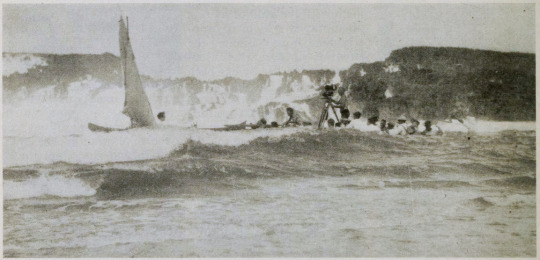
from American Cinematographer, February 1926]
I guess most of the suffering for art is done by the actors who tie themselves into knots to create the illusion of paralysis, amputated legs and so on. John Gilbert is shown in the last reels of "The Big Parade" with an amputated leg. Jack Barrymore in "The Sea Beast," also does it. It is merely a painful process of strapping the foreleg back. In "The Street of Forgotten Men," with Percy Marmont, a very lucid expose of cripple fakes is shown. Marmont had his arm strapped to his back for hours at a stretch during the filming of this picture. It hurts the first fifteen minutes, Percy said. After that the arm becomes numb.
A vigorous massage is necessary to bring it back to life, but it doesn't feel normal for weeks, Percy says.
Lon Chaney has his tricks of deformity down so pat that they are almost painless to him now.
#1920s#1910s#1926#classic film#classic movies#film#american film#my edits#silent film#my gifs#silent movies#silent era#silent cinema#cinema#film history#history#Roy Pomeroy#Frank Williams#Film Art#How'd They Do It#photoplay#lantern
58 notes
·
View notes
Text

Blade Runner 2049 fan poster illustrated by me, depicting the Sea Wall scene.
#digital art#digital painting#illustration#art#scifi#movies#blade runner#blade runner 2049#cyberpunk#cyberpunk aesthetic#cyberpunk art#scifi art#ryan gosling#film art#film poster#art of movies#cinema
55 notes
·
View notes
Text

Fallen Angels, (1995)
Dir - Wong-Kar Wai
#me posting songs on my tumblr#wong kar wai#movie scenes#good movie#movie stills#movies#movie quotes#movie art#movie aesthetic#film stills#film and television#film art#film aesthetic#films#chinese movie#90s movies#cinephile#cinema
36 notes
·
View notes
Text

just watched dune part 2
i will never be the same after this tbh
#aesthetic#art#alternative#photography#gif#timothée chalamet#paul atreides#dune movie#dune#dune part two#dune part 2#actors#actor#movie art#film gifs#filmcamera#denis villeneuve#dark#film art#timothee chamalet#scifi#cinemetography#cinephile#cinema
154 notes
·
View notes
Text

Happy Star Wars Day everyone!
Here's a sneak peek at something I worked on recently. Can't wait to fully share this one in the future! 👀
#Star wars day#star wars#may the 4th be with you#may the 4th#obi wan kenobi#leia#leia organa#darth vader#anakin skywalker#luke skywalker#ewan mcgregor#poster art#film art#movie art#jedi#princess leia
644 notes
·
View notes
Text

Magical mountain snow time lapse🏔️
#forest#green witch#lovely#plants#magick#myart#witchblr#witchcore#beauty#snow#timelapse#mountains#venusssl#sussan#film art#artists on tumblr#art#myself#magic
70 notes
·
View notes
Text
More people need to talk about the biblically accurate angels in Guillermo Del Toro's Pinocchio! BECAUSE THEY'RE BEAUTIFUL.
LOOK
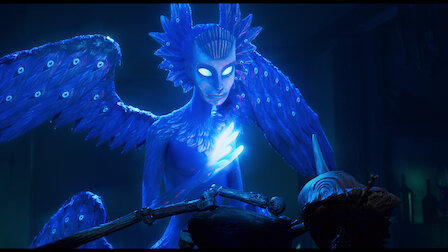
AT THEM
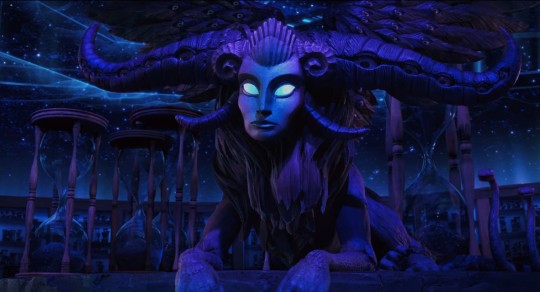
aaaaaaaaaaaaaaaaaaaaaa
#guillermo del toro#guillermo del toro's pinocchio#gdt pinocchio#text post#mexicanblanket#biblically accurate angel#pinocchio#art appreciation#film art#film#cinema
384 notes
·
View notes